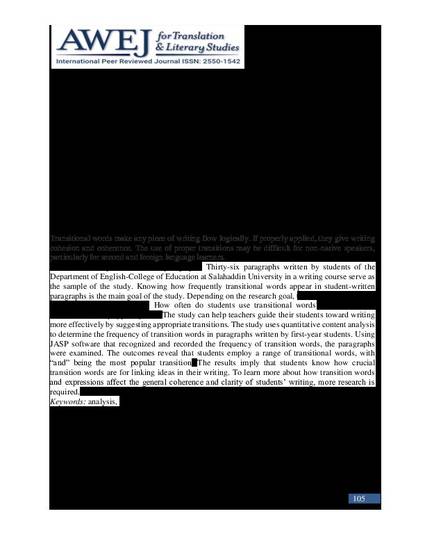
Article
Frequency Analysis of Transition Words in Students’ Paragraphs
AWEJ for Translation & Literary Studies
(2023)
Abstract
Transitional words make any piece of writing flow logically. If properly applied, they give writing cohesion and coherence. The use of proper transitions may be difficult for non-native speakers, particularly for second and foreign language learners. This study examines how frequently students use transitional phrases in their paragraphs. Thirty-six paragraphs written by students of the Department of English-College of Education at Salahaddin University in a writing course serve as the sample of the study. Knowing how frequently transitional words appear in student-written paragraphs is the main goal of the study. Depending on the research goal, the following questions are addressed by this study: How often do students use transitional words? What kinds of transitions do they typically use? The study can help teachers guide their students toward writing more effectively by suggesting appropriate transitions. The study uses quantitative content analysis to determine the frequency of transition words in paragraphs written by first-year students. Using JASP software that recognized and recorded the frequency of transition words, the paragraphs were examined. The outcomes reveal that students employ a range of transitional words, with “and” being the most popular transition. The results imply that students know how crucial transition words are for linking ideas in their writing. To learn more about how transition words and expressions affect the general coherence and clarity of students’ writing, more research is required.
Keywords
- analysis,
- frequency,
- paragraphs,
- students,
- transitions
Disciplines
Publication Date
Winter October 15, 2023
DOI
http://dx.doi.org/10.24093/awejtls/vol7no4.8
Citation Information
Baraat Ismael Faqe Abdulla. "Frequency Analysis of Transition Words in Students’ Paragraphs" AWEJ for Translation & Literary Studies Vol. 7 Iss. 4 (2023) p. 105 - 120 ISSN: 2550-1542 Available at: http://works.bepress.com/awejfortranslation-literarystudies/429/